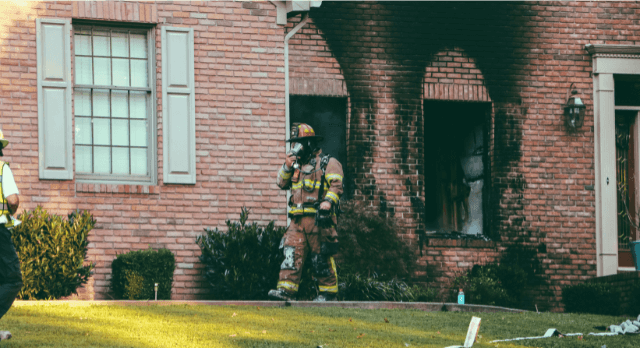Soot and debris are the two main issues that must be dealt with after house fires. Since soot particles spread quickly and contaminate places far from the fire’s source, the damage caused by them can be considerable. If not adequately cleaned, soot residue can result in further damage, which is why specific smoke damage removal procedures are necessary.
It is equally important to deal with the debris, which includes goods and materials that have been harmed. This includes clearing out burned items and determining what can be saved.
What Is Soot?
The incomplete combustion of organic materials, such as wood, fossil fuels, and other carbon-based compounds, results in the formation of soot, a fine black or dark brown powder. It is made up of minute carbon particles that are produced when the substance partially burns.
Various compounds can be found in soot residue, depending on what was burning and how hot it was. It is frequently combined with acids, chemicals from burned plastics or synthetic materials, and other chemicals created during the fire.
Because soot is a fine powder, it spreads readily and settles on various surfaces, causing contamination. Removing soot stains can be difficult because of their sticky, greasy texture that causes them to attach to surfaces.
Are soot particles dangerous to inhale?
Yes. Breathing in soot particles can be harmful, and you should use a face mask when dealing with black soot. It is full of harsh chemicals, as well as dust, metals, mud, and acids. When inhaled, these tiny particles pose serious health hazards since they can go deep into the lungs and even into the bloodstream.
Potential risks include coronary heart disease, respiratory problems, and other major health issues, especially for those who already have serious medical conditions like asthma or heart disease.
How to Remove Soot After a House Fire
One of the most important parts of the smoke damage repair process after a home fire is removing soot. The removal procedure consists of several crucial processes, each intended to handle the distinct characteristics of soot.
To ensure efficient and complete cleaning, every step of the process, from identifying soot stains to using cleaning solutions for the last rinse, requires close attention to detail and safety measures.
Locate the Soot Stains
Determine which locations are damaged by soot and start the soot removal process there. Examine surfaces such as furniture, brick walls, and ceilings for any obvious soot streaks. As a byproduct of incomplete combustion, soot can cover a large area and is typically seen as black or dark brown soot damage.
Examine the parts that are not readily apparent before removing soot. Pay close attention to window sills, cabinets, and behind appliances. Soot frequently builds up in vents and air ducts. Do not run your HVAC system before a professional says it’s safe.
Take into account the soot adherence when analyzing different materials and surfaces. For instance, soot tends to adhere differently to porous surfaces like wood and drywall than non-porous materials like metal or glass. Different kinds of surfaces require different cleaning techniques.
Protect Furniture
Cover furniture and unaffected surfaces with plastic or fabric sheets before you start cleaning to keep any loose soot particles from getting into clean areas. Use drop cloths or plastic sheeting on top of the furniture coverings to shield the floors from soot, dirt, and cleaning agents. This aids in shielding the surface from injury or discoloration while you remove soot.
Electronics are especially vulnerable to soot damage. Cover up or remove fixtures and electronic equipment from the space. By taking these measures before you start to clean soot, you can preserve your belongings and save time and effort.
Vacuum Dry Soot Residue
Dust off any stray soot particles with a vacuum equipped with a HEPA filter. Avoid brush attachments since they can cause soot to penetrate surfaces more deeply. Before wet cleaning, vacuuming aids in soot reduction in tough spots.
Go over all afflicted areas meticulously and slowly when you clean soot, as rushing can dislodge and disperse particles even more. To prevent the soot from grinding into materials, move the vacuum nozzle slightly above the surface instead of making direct contact with it. This is especially important for softer surfaces where soot can be embedded more deeply, such as carpets and upholstery.
Use Dry Cleaning or Soot Sponge
Use a soot sponge or dry cleaning sponge on hard surfaces that have soot residue on them. The purpose of these specialty sponges is to absorb soot without smearing it. The soot stain can be lifted and removed by gently wiping the impacted surfaces. This is a valuable solution for fragile surfaces on which you cannot use water.
Wash the Remaining Soot Stains With a Wet Cleaning Solution
Use warm water and a mild cleaning solution, such as dishwashing liquid and baking soda, to remove any soot residue left after dry cleaning. A solution of white vinegar and water can work well for more stubborn smoke stains. After lightly cleaning the surfaces with a soft cloth or soot sponges, rinse with warm water. Wearing gloves and protective gear is advised to prevent particle inhalation and skin irritation.
What is Debris?
Debris refers to remnants of materials and objects that have been damaged or destroyed during a house fire. It includes burned wood, drywall, and other structural components, burnt furniture, personal effects, and other household things impacted by smoke or water used to put out the fire.
Is it Safe to Clean Up After a Fire?
No, cleaning up after a fire is not safe. In most cases, you need to call a professional for safe and efficient cleanup.
Fires often undermine a building’s structural stability. Even with all necessary precautions, weakened walls, ceilings, and floors pose a risk of an accident or injury.
Fires also release toxic substances such as lead or asbestos that may be present in older homes. The risk of electrocution is significant as the electrical system might have been affected by both fire damage and water damage from firefighting efforts.
Finally, cleaning soot often involves potentially dangerous chemicals, so you shouldn’t try to remove soot stains on your own. As fire often moves through your air vents, you will also need a professional to sanitize your entire HVAC system. Otherwise, you will not only have an issue with severe smoke odors but also health risks from any remaining soot particles.
How Do You Get Rid of Fire Debris?
Hiring professionals is the best way to remove smoke and fire debris effectively. Safety and adherence to local laws ask for a deliberate and cautious approach.
Safety First
Safety measures for cleaning fire debris include inspecting the structural integrity of the building and wearing proper safety gear. Make sure an expert evaluates the building’s structural integrity to reduce the chance of collapses or further damage.
Fire cleanup comes with risks of mechanical injuries, hazardous airborne particles, and soot, ash, and even chemical burns that may irritate your skin.
Depending on the level of damage, proper protection may include hard hats, sturdy or steel-toe boots (as you may encounter shards or sharp metal items), coveralls, gloves, and face masks such as powered air respirators or an N95 mask.
The safest approach is to call a professional, as improper cleaning protocols tend to cause further damage to your belongings and health.
Salvage Furniture and Items
Carefully consider what can be recovered. If there is noticeable soot buildup, it is best to call a soot and smoke professional. Most things that haven’t been severely harmed by smoke, fire, or water can be cleaned and repaired. However, evaluating each item honestly is crucial because some may be beyond repair and must be thrown away.
The most effective method for cleaning metal surfaces is to use a commercial rust removal product that contains phosphoric or oxalic acid, but be sure to wear gloves.
Follow the City/County Code for Debris Removal
Respect the laws and ordinances in your area regarding the removal of debris. In the Portland area, including Washington County, Multnomah County, Yamhill County, and Clackamas County, specific rules might apply to the disposal of fire-damaged goods.
The purpose of these rules is to guarantee environmentally responsible and safe disposal. You can get guidance on appropriate disposal techniques and approved facilities by contacting the local waste management authority.
Handle Debris With Caution
Fire debris may contain hazardous elements or jagged, unstable shards, so rubber gloves should be worn during the initial assessment. However, it’s best to engage experts who are experienced in handling post-fire situations. They are equipped and have the experience to handle a variety of debris types safely and effectively.
Contact a Debris and Soot Removal Company
In cases of fire damage, contacting a professional debris and soot cleaning firm is generally the best line of action. These businesses have the know-how, tools, and safety procedures to manage the difficulties of soot damage restoration. They can safely remove debris and deal with lingering soot residue, which is dangerous if not handled properly.
PacWest Restoration is a dependable choice for people in need of fire damage and water damage restoration services, especially in Portland, Washington County, Multnomah County, Yamhill County, and Clackamas County. Contact us through our online form or call us 24/7 at 503-746-6545.
Our staff will ensure that the cleaning, sanitization, and restoration procedure is carried out thoroughly, securely, and in accordance with the highest standards.


